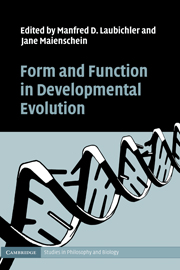Book contents
- Frontmatter
- Contents
- List of figures
- List of tables
- List of contributors
- List of journal abbreviations
- 1 Introduction
- 2 Form and function in Evo Devo: historical and conceptual reflections
- 3 Deducing plant function from organic form: challenges and pitfalls
- 4 Evolution in the light of embryos: seeking the origins of novelties in ontogeny
- 5 A focus on both form and function in examining selection versus constraint
- 6 Innovation and diversity in functional morphology
- 7 The developmental evolution of avian digit homology: an update
- 8 Functional analysis and character transformation
- 9 The nature of constraints
- 10 Toward a mechanistic Evo Devo
- Index
- References
1 - Introduction
Published online by Cambridge University Press: 28 June 2009
- Frontmatter
- Contents
- List of figures
- List of tables
- List of contributors
- List of journal abbreviations
- 1 Introduction
- 2 Form and function in Evo Devo: historical and conceptual reflections
- 3 Deducing plant function from organic form: challenges and pitfalls
- 4 Evolution in the light of embryos: seeking the origins of novelties in ontogeny
- 5 A focus on both form and function in examining selection versus constraint
- 6 Innovation and diversity in functional morphology
- 7 The developmental evolution of avian digit homology: an update
- 8 Functional analysis and character transformation
- 9 The nature of constraints
- 10 Toward a mechanistic Evo Devo
- Index
- References
Summary
When philosopher of biology Michael Ruse moved from Guelph, Ontario, to Florida State University, a very good thing happened for our understanding of the conceptual, historical, and philosophical foundations of biology. Ruse became the William H. and Lucyle T. Werkmeister Professor, which brought with it an endowment that allowed him to organize conferences on a regular basis. As usual, Michael Ruse lost no time, and the resulting series of conferences has brought together biologists, historians, and philosophers in lively discussion of a number of important topics. A favorite image of those events is that of Ernst Mayr, sitting in the boat during a swamp tour on a drowsy Florida afternoon. The aging but ever-intense Mayr seemed to be dozing, when suddenly he pointed and declared a noteworthy bird, then another, and another. That led to a discussion of whether biodiversity is declining; then to philosophical questions about how we count diversity; and finally to ethical and policy questions of why we care. Other conferences have led to debates about science and religion. And so on.
In 2005, a group of leading biologists joined philosophers and historians for four days of thinking about form and function. For this meeting, Ruse followed his usual approach. He provided the general theme, brought together a mix of enthusiastic scholars, and waited to see what happened. In this case, it was something very interesting.
- Type
- Chapter
- Information
- Form and Function in Developmental Evolution , pp. 1 - 9Publisher: Cambridge University PressPrint publication year: 2009

